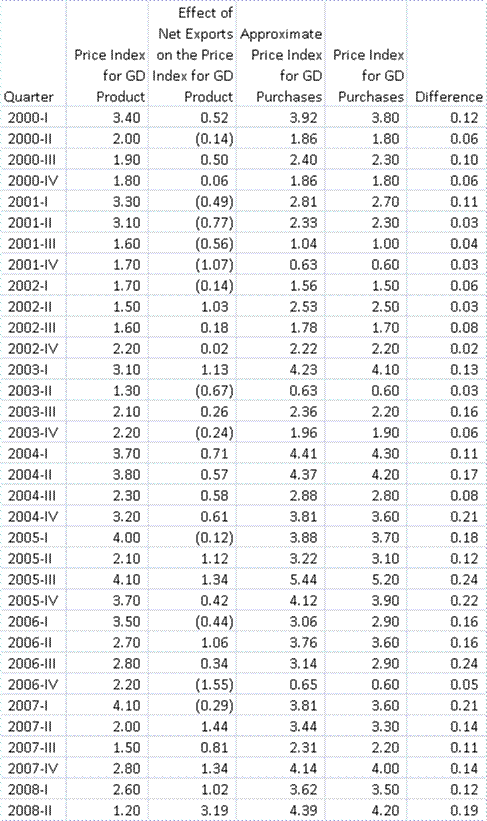Another Look at Preliminary Second Quarter GDP
The National Income and Product Account [NIPA] statistics are complex.? When I was an undergraduate student in economics I remember getting confused by them, but by the time I was a graduate student in economics, and began to dig into how the indexes are constructed, I became more comfortable with them.? Well, that’s 25 years in the rear-view mirror, but perhaps I can contribute something on the current Real GDP figure.
When the recent preliminary second quarter GDP number came out, it surprised a lot of observers, who were varyingly skeptical, because it was revised upward from 1.9% to 3.3% annualized, and the economy seems weak.? Among those surprised/objecting:
- Economists cited by Odd Numbers
- Naked Capitalism
- The Big Picture
- … to name a few
I’ve commented on this before, after the advance release of second quarter GDP.? My main point was that real Gross Domestic Product covers increases in production in the US, adjusted for price changes, whereas real Gross Domestic Purchases covers the increase in purchasing power for the average consumer in the US.? These are different concepts, but they track pretty closely, ordinarily.
You can find how the two concepts relate here, in this definition of Gross Domestic Purchases:
Gross domestic purchases
The market value of goods and services purchased by?U.S. residents, regardless of where those goods and services were produced. It is?gross domestic product (GDP) minus?net exports of goods and services. Equivalently, it is the sum of?personal consumption expenditures (PCE),?gross private domestic investment, and?government consumption expenditures and gross investment.
Source: U.S. Bureau of Economic Analysis
Okay, so when I read Barry’s article at The Big Picture, I made this comment:
Barry, maybe you can straighten me out on this one… oil was up 25% in the second quarter (2Q avg / 1Q avg). Since they deduct imports in the calculation of nominal GDP, they have to do a similar deduction in the corresponding deflator. So, a large rise in oil/energy prices leads to a decrease in the deflator, leading to higher “real” GDP. Is that how this is working?
What that means is that GDP is asking the wrong question. It answers the question: how much more was produced inside the US compared to prior periods, adjusted for the prices on what was produced.
What I think reflects the sense of the average person in our country is the gross domestic purchase series, which represents how much more has been purchased compared to prior periods, adjusted for the prices on what was purchased. That series shows 0.4% growth over the last year, and 0.1% growth over the last 6 months.
That’s what I think the core of the story is. You agree?
Posted by: David Merkel | Sep 1, 2008 1:05:21 PM
Another way to say it, is that the differences between the price indexes for Gross Domestic Product and Gross Domestic Purchases comes down to the changes in the prices of net exports (exports less imports).? Using data for the price indexes for Gross Domestic Product and Gross Domestic Purchases, I tried to test this hypothesis with data since 2000.

Now, it’s not exact, but it is close.? the average difference is 0.12%, and probably reflects some reweighting between the two indexes.? So, I think the surprise in the Real GD Product number of 3.3% comes from net exports.
Admittedly, this is perverse, as I noted in my comment to Barry, but that is how these statistics are designed.? The increase in energy prices in the second quarter fed into the Gross Domestic Purchases price index, but not directly into the Gross Domestic Product price index, because net exports get deducted.
The two statistics answer different questions:? Real Gross Domestic Product increased at a 3.3% annualized rate in the second quarter: net production in the US is doing well.? Real Gross Domestic Purchases increased at a 0.2% annualized rate, which means average consumers are not benefiting much from the increase in real production.? But, perhaps that is to be expected, because if the US is ever going to begin to balance its current account, it will mean more production relative to consumption in the US than at present.? That will feel more like recession than growth.
That’s how things feel now.? In summary, the reason the 3.3% real GDP number looks weird is that imports have a negative weight in the GD Product price index, so a large move up in energy prices (largely imported) makes the GDP product price index go down, and real GDP go up.? Real GD purchases treats the rise in energy prices as a real price increase to consumers, and so it rises at 0.2% annualized.? Some difference, and no surprise that many consumers don’t feel things are getting much better for them at present.

